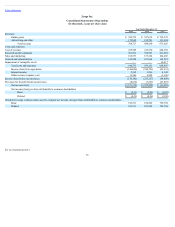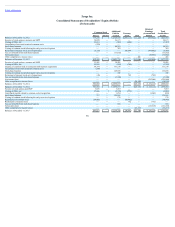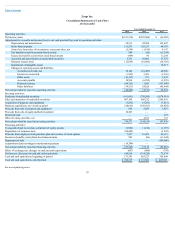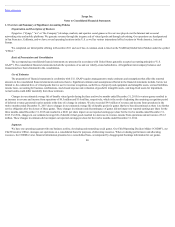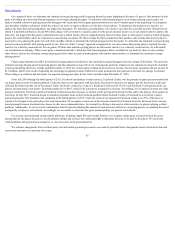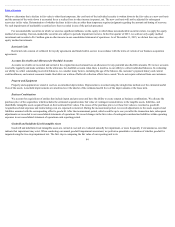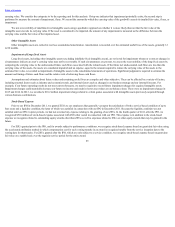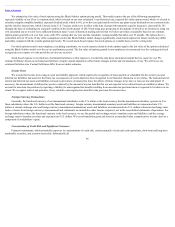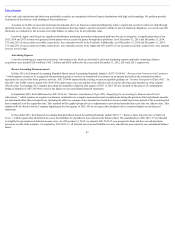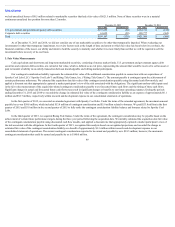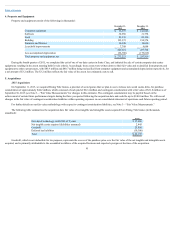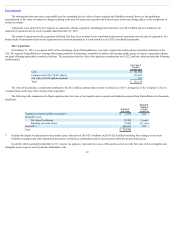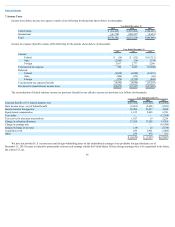Zynga 2015 Annual Report Download - page 89
Download and view the complete annual report
Please find page 89 of the 2015 Zynga annual report below. You can navigate through the pages in the report by either clicking on the pages listed below, or by using the keyword search tool below to find specific information within the annual report.
Table of Contents
We estimate the fair value of stock options using the Black-Scholes option-pricing model. This model requires the use of the following assumptions:
expected volatility of our Class A common stock, which is based on our own calculated 3 year historical rate; expected life of the option award, which we elected to
calculate using the simplified method; expected dividend yield, which is 0%, as we have not paid and do not have any plans to pay dividends on our common stock;
and the risk-free interest rate, which is based on the U.S. Treasury yield curve in effect at the time of grant with maturities equal to the grant’s expected life. We
changed the basis of estimating our expected volatility in the fourth quarter of 2015 from using peer group data in the industry in which we do business to using our
own calculated rate as we now have sufficient historical data (3 years of historical trading activity) that we believe provides a reasonable basis for our estimate.
Option grants generally vest over four years, with 25% vesting after one year and the remainder vesting monthly thereafter over 36 months. The options have a
contractual term of 10 years. If any of the assumptions used in the Black-Scholes model changes significantly, stock-based expense for future awards may differ
materially compared with the awards granted previously. We record stock-based expense for stock options on a ratable basis over the vesting term.
For stock options issued to non-employees, including consultants, we record expense related to stock options equal to the fair value of the options calculated
using the Black-Scholes model over the service performance period. The fair value of options granted to non-employees is remeasured over the vesting period and
recognized as an expense over the period the services are received.
Stock-based expense is recorded net of estimated forfeitures so that expense is recorded for only those stock-based awards that we expect to vest. We
estimate forfeitures based on our historical forfeiture of equity awards adjusted to reflect future changes in facts and circumstances, if any. We will revise our
estimated forfeiture rate if actual forfeitures differ from our initial estimates.
IncomeTaxes
We account for income taxes using an asset and liability approach, which requires the recognition of taxes payable or refundable for the current year and
deferred tax liabilities and assets for the future tax consequences of events that have been recognized in our financial statements or tax returns. The measurement of
current and deferred tax assets and liabilities is based on provisions of enacted tax laws; the effects of future changes in tax laws or rates are not anticipated. If
necessary, the measurement of deferred tax assets is reduced by the amount of any tax benefits that are not expected to be realized based on available evidence. We
account for uncertain tax positions by reporting a liability for unrecognized tax benefits resulting from uncertain tax positions taken or expected to be taken in a tax
return. We recognize interest and penalties, if any, related to unrecognized tax benefits in the provision for income taxes.
ForeignCurrencyTransactions
Generally, the functional currency of our international subsidiaries is the U.S. dollar or the local currency that the international subsidiary operates in. For
these subsidiaries where the U.S. dollar is not the functional currency, foreign currency denominated monetary assets and liabilities are remeasured into U.S.
dollars at current exchange rates and foreign currency denominated nonmonetary assets and liabilities are remeasured into U.S. dollars at historical exchange rates.
Gains or losses from foreign currency remeasurement and settlements are included in other income (expense), net in the consolidated statements of operations. For
foreign subsidiaries where the functional currency is the local currency, we use the period-end exchange rates to translate assets and liabilities, and the average
exchange rates to translate revenues and expenses into U.S. dollars. We record translation gains and losses in accumulated other comprehensive income (loss) as a
component of stockholders’ equity.
ConcentrationofCreditRiskandSignificantCustomers
Financial instruments, which potentially expose us to concentrations of credit risk, consist primarily of cash and cash equivalents, short-term and long-term
marketable securities, and accounts receivable. Substantially all
86


